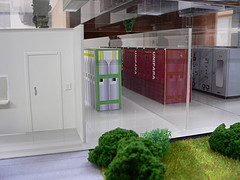
- Image by HDScorp via Flickr
A green computer or green IT system is one where the entire process from design, manufacture, use, and disposal involves as little environmental impact as possible. In other words, a green initiative is taken in consideration of all facets of a computer’s life, from design to disposal.
In the design aspect, a green computer is created to perform without a negative environmental impact. Such design includes everything from materials and components to how the computer uses its power supply. Nowadays, most computers are built with a sleep or hibernate mode that allows them to power down when not in use and, therefore, save on energy impact.
A green computer will also take into account how it impacts the environment during its life. One way to make a green computer reduce its usage impact is to extend its longevity. The longer the computer lasts, the less impact it will have on the environment because disposal, normally the most significant green influence of the computer’s cycle, will be delayed for a longer period of time. To increase a computer’s longevity, we suggest looking toward upgrades and modularity. For example, building a new computer from scratch produces a greater environmental effect than building a new RAM module for replacement in computing equipment.
computer virtualization is helping to make large strides in green computing technology. Through the phenomenon of virtualization, it is now possible to operate two or more computers on the physical hardware of a single computer. In this manner, you could create the ultimate green computer; one that exists logically, but not physically. The logical units use all the material components of the physical computer, but are devoid of physical structure themselves. This means that the environmental impact of logical computers is virtually eliminated. The ideal green computer, therefore, may lie in virtual green computing.
Terminal servers can also be used to create a greener computer. When using a terminal server, you are connected to a central terminal where all the computing is done. The operating system is experienced by the end user on the terminal. These terminals can be matched up to thin clients who depend on the server to do most of their computing. This type of green computing setup typically consumes as little as one eighth of the energy of a conventional workstation.
Some of the world’s leading companies that engage in green computing by researching green technology, developing energy efficient products, using sustainable materials, offering recycling programs, and marketing a greener look and feel, include well-known brands such as:
One of the biggest challenges to successful green computing is disposal. Many computers contain harmful elements such as lead, mercury, and others. Safely recycling these computers has become of more and more concern in recent years. It is a good idea to consider donating your old PC to a charity or having it re-purposed for use in some other capacity.
Often parts from out-dated computers can be salvaged through recycling centers. Perhaps, you can give your old computer away to someone who doesn’t have one and would be happy for your used unit.
So, now you know that green computing can be created in different ways. Everything from your existing computer, with upgrades and modularity, to a virtual computer that exists only in logic, can be a green computer.
If you are interested in learning more about ways to go green, save money and help the planet, go to www.FreeTipsForGoingGreen.com and subscribe to receive a FREE email daily containing great green living tips for making your home, office and life greener and more eco friendly. For more details, visit Greening Your Office
Related articles
- Going Green with Your Technology – Computers (brighthub.com)


